INTERESTING
AND FUN FACTS ABOUT CRICKETS
PAGE
CONTENTS
Chirping
Brief History Lesson Identification
Species
Chart
House Crickets
Field Crickets
Ground Crickets
Snowy Tree Crickets
Camel Crickets
Northern Mole Crickets
Nutritional Value of Crickets
Jimmy's Story
There are special songs for courtship, fighting and sounding
an alarm. The principle role is to bring the sexes together with different songs
in different species. Male crickets stridulate or "sing" by rubbing a sharp edge
(the scraper) at the base of one front wing along a file like ridge (the file)
on the bottom side of the other front wing, resulting in a series of "chirps."
The number of chirps varies with the temperature with more (faster) chirping at
higher temperatures. Chirps vary from four to five to more than 200 per second.
The song is amplified by the wing surface. Only the male cricket chirps.
Enter the number of chirps counted
in 15 seconds and click ENTER
Due to
formula static "0" shows a value of 40F and 4.44444C
CHIRP TO THE TOP
Achetus Domesticus or House
Cricket was first introduced into Canada and the United States in the 18th
century. They are less of a problem today because of modern building designs,
but there are many stories of swarms and infestations as late as the 1930's.
Back (1936) describes a plague of crickets
that migrated from a waste paper dump to homes nearby in Baltimore.
"No crickets were in evidence through out the
day except as they were exposed during a careful search of the rubbish, but upon
the approach of dusk, hoards, in all stages of growth, began emerging from the
debris in the dumps and swarmed upon tree trunks and over the ground between the
dump and the nearest dwellings, a distance of several hundred feet. the winged
forms flew readily, particularly after the city lights were turned on, and
telephone and electric poles along the streets became covered with crickets."
Janjua (1939) tells of swarms of Achetus
domesticus in India in which the swarms were 220 yards long and 100 yards wide.
Well you would not have to worry about food for your herp, but
there would be many side effects, including damaged clothing and contaminated
food (human).
Crickets are common pets in China. They have specially
designed "carrying cages" so they can travel with their pets.
There are many classroom "projects" involving raising and
studying crickets. Some of which include breeding, observing territorial
behavior and "jumping" contests.
CHIRP TO THE TOP
Crickets get their name from the high-pitched sound or "chirp"
produced when the male rubs his front wings together to attract a female.
Different kinds of crickets can be identified by listening to their song.
The "True Crickets" (House, Field, Ground, Tree) resemble
longhorned grasshoppers in having long tapering antennae, striculating (singing)
organs on the front wings of the male and auditory (hearing) organs on the front
tibiae (4th leg segment)
CHIRP TO THE TOP
SPECIES CHART
|
Common Name
|
Scientific Name
|
|
House Cricket
|
Acheta domesticus (Linnaeus)
|
|
Field Cricket
|
Gryllus spp.
|
|
Ground Cricket
|
Gryllus abbreviatus
Serville
|
|
Nemobius fasciatus (DeGeer)
|
|
Snowy Tree Cricket
|
Oecanthus niveus
(DeGeer)
|
|
Camel Cricket
|
Ceuthophilus
spp.
|
|
Northern Mole
Cricket
|
Neocurtilla hexadactyla (Perty)
|
CHIRP TO THE TOP
Life Cycle and Habits
House Crickets
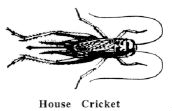 normally live
outdoors especially in garbage
dumps, preferring warm weather,
but will move indoors when it
gets colder usually in late
summer. Overwintering occurs
outdoors in the egg stage. Each
female can lay an average of 728
eggs with the immature crickets
(nymphs) resembling the adults
except being wingless. Nymphs
molt seven to eight times and
reach adulthood in about 60
days. Also, these crickets can
live indoors, completing their
life cycle with eggs laid in
cracks, crevices and other dark
areas such as behind baseboards.
normally live
outdoors especially in garbage
dumps, preferring warm weather,
but will move indoors when it
gets colder usually in late
summer. Overwintering occurs
outdoors in the egg stage. Each
female can lay an average of 728
eggs with the immature crickets
(nymphs) resembling the adults
except being wingless. Nymphs
molt seven to eight times and
reach adulthood in about 60
days. Also, these crickets can
live indoors, completing their
life cycle with eggs laid in
cracks, crevices and other dark
areas such as behind baseboards.
Adults are
very attracted to lights, and
become active at night (hide
during the day) to crawl, jump
or fly sometimes in countless
numbers up the sides of houses,
entering openings of even second
and third story windows and roof
skylights. The continued,
monotonous "chirp" is loud and
distracting, resulting in lost
sleep. They will feed on silk,
woolens, nylon, rayon and wood.
They can bite when handled
carelessly. They are found in
fields, pastures, lawns,
roadsides and in woods.
House Cricket
Adults are
about 3/4 to 7/8 inch long,
light yellowish-brown
(straw-colored), with three dark
bands on the head and have long,
slender antennae much longer
than the body. Wings lay flat on
the back but are bent down
abruptly on the sides. Females
have a long, slender, tube like
structure (ovipositor)
projecting from their abdomen
(spearhead at the tip) for
egg-laying. Both males and
females have two antenna-like
(cerci) attached to the sides at
the end of the abdomen.
CHIRP TO THE TOP
Field Crickets
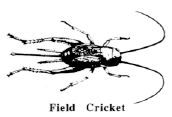 overwinter as
eggs or nymphs in moist, firm
soil. Each female lays between
150 to 400 eggs which hatch in
the spring. Nymphs resemble
adults except are smaller and
wingless, molt eight to nine
times and reach adulthood in
about 90 days. They are serious
agricultural pests feeding on
many crop plants. They become
household pests in late summer
and early fall when they move
out of fields and into
buildings. They can damage
furniture, rugs and clothing and
the "chirping" of adult males
can be irritating. They are
readily attracted to lights, can
fly and are often found around
dumpsters. Large swarms may
invade well-lighted areas
covering streets and the sides
of buildings black with
crickets. They feed on nylon,
wood, plastic fabrics, thin
rubber goods and leather.
Outbreaks occur when rainfall
follows a period of drought.
overwinter as
eggs or nymphs in moist, firm
soil. Each female lays between
150 to 400 eggs which hatch in
the spring. Nymphs resemble
adults except are smaller and
wingless, molt eight to nine
times and reach adulthood in
about 90 days. They are serious
agricultural pests feeding on
many crop plants. They become
household pests in late summer
and early fall when they move
out of fields and into
buildings. They can damage
furniture, rugs and clothing and
the "chirping" of adult males
can be irritating. They are
readily attracted to lights, can
fly and are often found around
dumpsters. Large swarms may
invade well-lighted areas
covering streets and the sides
of buildings black with
crickets. They feed on nylon,
wood, plastic fabrics, thin
rubber goods and leather.
Outbreaks occur when rainfall
follows a period of drought.
There are
many different kinds and sizes
of field crickets, none of which
are able to survive and
reproduce in buildings. They are
found outdoors in similar places
as are house crickets,
especially under stones or
boards, entering cool, moist
basements in hot summers.
Field Cricket
Adults range
in size from 1/2 to 1-1/4 inches
long depending on the species,
are usually black-colored
(sometimes brown), have long,
slender antennae and a typical
stout body (more robust than the
house cricket) with large
"jumping" hind legs. The
ovipositor may be up to 3/4 inch
long. Females have three easily
seen appendages coming out of
the tip of the abdomen, whereas
males have only two. Most chirp
and may sing both day and night.
CHIRP TO THE TOP
Ground
Crickets
act similar to
field crickets except are
smaller, overwinter as eggs, are
largely active at night and
attracted to lights. They occur
in pastures, lawns and wooded
areas.
Ground
Cricket
Adults
resemble house and field
crickets but are much smaller,
usually less than 1/2 inch long,
and brownish. Spines on the hind
tibiae are long and movable.
Their songs are often soft,
high-pitched, pulsating trills
or buzzes.
CHIRP TO THE TOP
Snowy Tree
Crickets
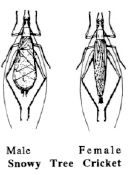 occur in trees,
shrubs, weeds and high grass and
are excellent singers, chirping
at a regular rate varying with
the temperature. Eggs are laid
in the bark or stems of fruit
and ornamental plants, often
seriously damaging the twigs
during the process of egg
laying. Eggs are laid in
pin-size holes (usually in
single rows), sometimes injuring
brambles of bush fruits.
Overwintering eggs hatch in the
spring with nymphs maturing in
late summer. Apple, peach, plum,
prune, cherry and berries are
food hosts.
occur in trees,
shrubs, weeds and high grass and
are excellent singers, chirping
at a regular rate varying with
the temperature. Eggs are laid
in the bark or stems of fruit
and ornamental plants, often
seriously damaging the twigs
during the process of egg
laying. Eggs are laid in
pin-size holes (usually in
single rows), sometimes injuring
brambles of bush fruits.
Overwintering eggs hatch in the
spring with nymphs maturing in
late summer. Apple, peach, plum,
prune, cherry and berries are
food hosts.
Snowy
Tree Cricket
Adults are
about 5/6 to 7/8 inch long, pale
yellowish - green or whitish
shaded pale green and have a
single black spot on the front
side of each of the first two
antennal segments. Male wings
are broad, paddle-like, and lay
flat on the back at rest,
whereas the female forewing is
narrow, and wrapped closely
about the body. They chirp at a
regular rate varying with the
temperature. A good
approximation of the temperature
in degrees Fahrenheit is to add
40 to the number of chirps in 15
seconds. These are the crickets
commonly heard in the background
noises of TV and movies. Most
deliver loud trills.
CHIRP TO THE TOP
Camel
Crickets
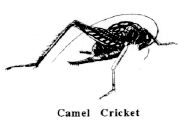 are active at
night in cool, damp, dark areas
and occasionally invading damp
basements or crawlspaces. They
are not attracted to lights nor
produce songs. Overwintering
occurs as nymphs or adults in
protected places. They may be
found living in large numbers,
causing alarm. Some textiles may
be damaged. Some hide under hay
bales, feeding on other insects
seeking shelter there. Most are
found in caves, hollow trees,
under logs and stones and in
other dark, moist places. They
can live and reproduce indoors.
are active at
night in cool, damp, dark areas
and occasionally invading damp
basements or crawlspaces. They
are not attracted to lights nor
produce songs. Overwintering
occurs as nymphs or adults in
protected places. They may be
found living in large numbers,
causing alarm. Some textiles may
be damaged. Some hide under hay
bales, feeding on other insects
seeking shelter there. Most are
found in caves, hollow trees,
under logs and stones and in
other dark, moist places. They
can live and reproduce indoors.
Camel
Cricket
Adults,
sometimes called cave or cellar
crickets, are a little over 3/4
inch long, light tan to dark
brown (darker bands on some
segments), wingless, with head
bent downward, back arched
(humpbacked appearance), large
hind legs and long antennae.
CHIRP TO THE TOP
Northern
Mole Crickets
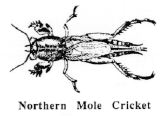 spend most of
their life burrowing in the
soil, coming to the surface as
the soil is wet or flooded with
rain. They are not often pests,
but sometimes enter basements or
homes. They fly to lights during
their spring mating period.
Females lay eggs in the soil (35
eggs per cell). Eggs hatch in 10
to 40 days with adulthood
reached by autumn. They feed on
roots, tubers and underground
stems of grasses, strawberries,
vegetables, etc. They overwinter
as adults in the soil.
spend most of
their life burrowing in the
soil, coming to the surface as
the soil is wet or flooded with
rain. They are not often pests,
but sometimes enter basements or
homes. They fly to lights during
their spring mating period.
Females lay eggs in the soil (35
eggs per cell). Eggs hatch in 10
to 40 days with adulthood
reached by autumn. They feed on
roots, tubers and underground
stems of grasses, strawberries,
vegetables, etc. They overwinter
as adults in the soil.
Northern Mole Cricket
Adults are 1/2
to 1-1/4 inches long, brownish
to blackish-brown, with beadlike
eyes. Their broad front legs are
adapted for "digging" (they
resemble front feet of a mole).
They have rather short antennae,
a large head and can fly.
Nutritional Value of Crickets
Compared to
other commercially available
insects, crickets are a GREAT
herp food. They are high in
protein, around 24%, about the
same or just barely less than
mealworms (which are somewhat
harder to digest). They are low
in fat, just over 9% (only flies
are lower at 7.5%). At about
0.04% calcium content, crickets,
like most insects, are a fairly
poor source of calcium. They are
higher in calcium than either
mealworms or waxworms (both at
about 0.02%) but lower than
flies (0.06%). There are no
significant differences in the
carbohydrate, fiber and moisture
contents. These numbers are from
one industry source. Numbers
from other analyses or sources
may vary, but comparatively the
results should be about the
same.
CHIRP TO THE TOP
Jimmy the cricket has chirp,
will travel
By Dan Rodricks
I
get this tip about an
80-year-old woman with a pet
cricket. Not just any pet
cricket. An 11-year-old pet
cricket named Jimmy. So,
intrigued, I make a phone call.
I get the 80-year-old woman on
the phone at her apartment in
Elkridge, Howard County. She's
very pleasant. She says she
moved to the Baltimore area from
her native Buffalo, N.Y. during
the winter. The cricket came
with her.
"How do you
know the cricket is 11 years
old?" I ask.
"Because,"
she says, "this went on for 11
years, and my house in Buffalo
had screens and bars on all the
windows. How could he get out?"
"The same
way he got in?" I asked.
"Well," she
says, "all I can tell you is
Jimmy -- that's his name --got
in my house and stayed with me
all those years. He chirped when
I was around. He lived in the
cellar and, in the winter, he
used to stay right on the
furnace to keep warm. When I
went on vacation, I used to
leave the radio on to keep him
company."
"And Jimmy
came with you to Maryland?"
"I moved
down here in February by
myself," she says. "And four
days after I moved in, I started
hearing him chirp again. I think
he knew I was leaving Buffalo
and found some way of getting
here."
"You mean,
you didn't bring him with you?"
"No, I've
never seen him."
"You've
never seen him?"
"No, but he
chirps. But he only chirps when
I'm around, and he never chirps
when I'm in bed. He knows not to
keep me awake, a very educated
cricket."
"Are you
sure you don't need a new
battery for your smoke detector?
It chirps when the battery's
low."
"Oh, it's
not a smoke detector. It's a
cricket. This little cricket has
brought me so much happiness. He
thinks the world of me."
I called
the chairman of the entomology
department at the University of
Maryland yesterday to ask how
long crickets live and whether
they can bond with humans. Mike
Raupp didn't get back to me
right away. But that's OK. Why
spoil the woman's story with
science?
CHIRP TO THE TOP
literature
cited (10)
|